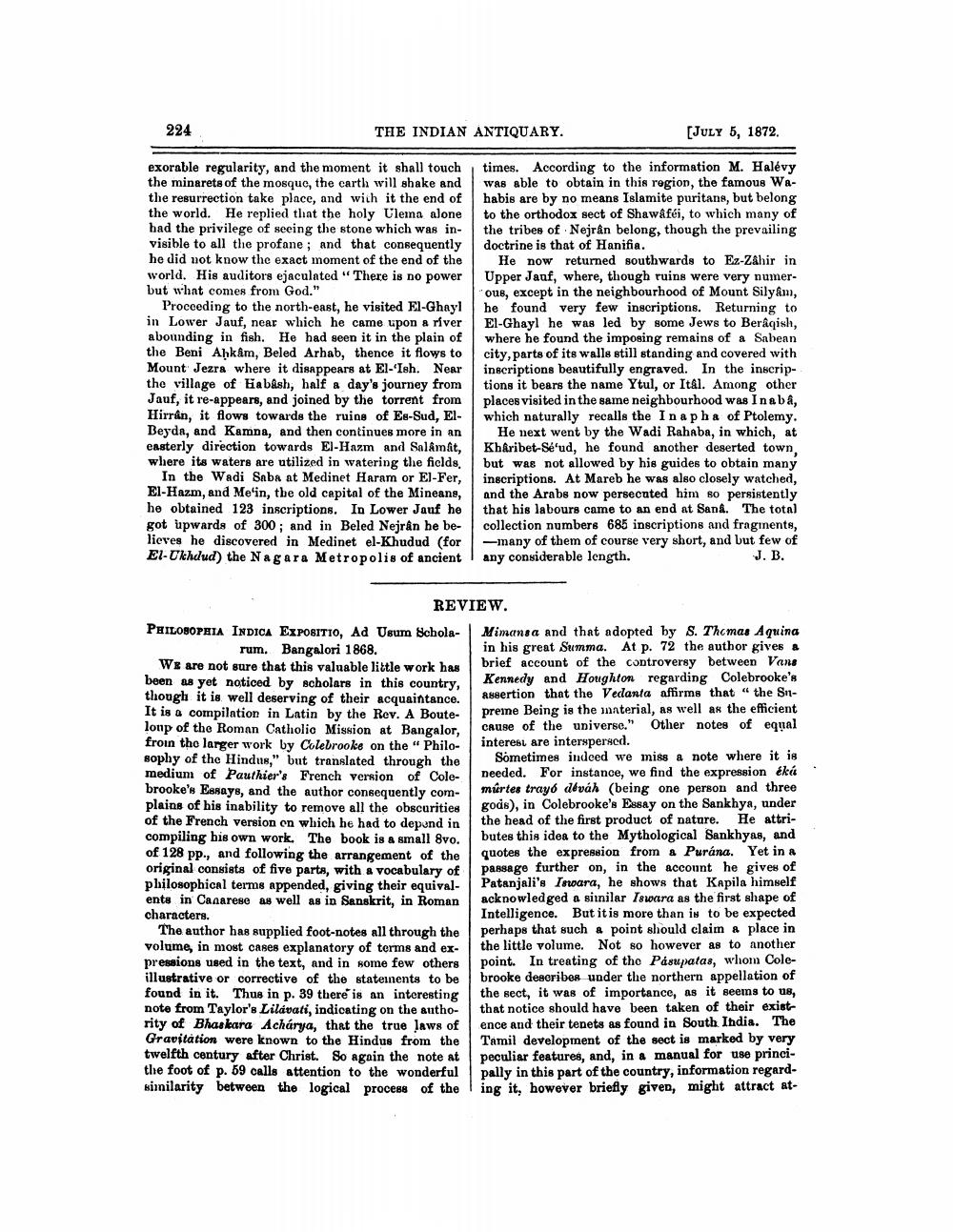________________
224
THE INDIAN ANTIQUARY.
[JULY 5, 1872
exorable regularity, and the moment it shall touch the minarets of the mosquc, the cartha will shake and the resurrection take place, and with it the end of the world. He replied that the holy Ulema alone had the privilege of seeing the stone which was invisible to all the profane; and that consequently he did not know the exact moment of the end of the world. His auditors ejaculated "There is no power but what comes from God."
Proceeding to the north-east, he visited El-Ghayl in Lower Jauf, near which he came upon a river abounding in fish. He had seen it in the plain of the Beni Ahkam, Beled Arhab, thence it flows to Mount Jezra where it disappears at El-'Ieh. Near the village of labash, half a day's journey from Jauf, it re-appears, and joined by the torrent from Hirrán, it flows towards the ruins of Es-Sud, ElBeyda, and Kamna, and then continues more in an easterly direction towards El-Hazm and Salamat, where its waters are utilized in watering the fields,
In the Wadi Saba at Medinet Haram or El-Fer, El-Hazm, and Me'in, the old capital of the Mineans, he obtained 123 inscriptions. In Lower Jauf he got upwards of 300; and in Beled Nejrân he be- lieves he discovered in Medinet el-Khudud (for El-Ukhdud) the Nagara Metropolis of ancient
times. According to the information M. Halévy was able to obtain in this region, the famous Wahabis are by no means Islamite puritans, but belong to the orthodox sect of Shaw&féi, to which many of the tribes of Nejrån belong, though the prevailing doctrine is that of Hanifia.
He now returned southwards to Ez-Zahir in Upper Jauf, where, though ruins were very numerOue, except in the neighbourhood of Mount Sily&m, he found very few inscriptions. Returning to El-Ghayl he was led by some Jews to Berâqish, where he found the imposing remains of a Sabean city, parts of its walls still standing and covered with inscriptions beautifully engraved. In the inscriptions it bears the name Ytul, or Ital. Among other places visited in the same neighbourhood was Inaba, which naturally recalls the Inapha of Ptolemy.
He next went by the Wadi Rahaba, in which, at Khåribet-Sé ud, he found another deserted town. but was not allowed by his guides to obtain many inscriptions. At Mareb he was also closely watched, and the Arabs now persecuted him Bo persistently that his labours came to an end at San&. The total collection numbers 685 inscriptions and fraginents, 1 many of them of course very short, and but few of any considerable length.
J. B.
REVIEW. PHILOSOPHIA INDICA EXPOSITIO, Ad Usum Schola- Mimansa and that adopted by S. Thomas Aquina rum. Bangalori 1868.
in his great Summa. At p. 72 the author gives & We are not sure that this valuable little work has
brief account of the controversy between Vans been as yet noticed by scholars in this country,
Kennedy and Houghton regarding Colebrooke's though it is well deserving of their acquaintance.
assertion that the Vedanta affirms that “the S1It is a compilation in Latin by the Rev. A Boute
preme Being is the material, as well as the efficient lonp of the Roman Catholio Mission at Bangalor,
CAUSE of the universe." Other notes of equal froin tho larger work by Colebrooke on the " Philo
interest are interspersed. sophy of the Hindus," but translated through the
Sometimes indeed we miss a note where it is medium of Pauthier's French version of Cole
needed. For instance, we find the expression éká brooke's Essays, and the author consequently com
múrtes trayó dáváh (being one person and three plains of his inability to remove all the obscurities gods), in Colebrooke's Essay on the Sankhya, under of the French version on which he had to depend in the head of the first product of nature. He attricompiling his own work. The book is a small 8vo.
butes this idea to the Mythological Sankhyas, and of 128 pp., and following the arrangement of the
quotes the expression from & Purana. Yet in a original consists of five parta, with a vocabulary of
passage further on, in the account he gives of philosophical terms appended, giving their equival- Patanjali's Teroara, he shows that Kapila himself ents in Casarese as well as in Sanskrit, in Roman
acknowledged a siunilar Iswara as the first shape of characters.
Intelligence. But it is more than is to be expected The author has supplied foot-notes all through the perhaps that such a point should claim a place in volume, in most cases explanatory of terms and ex
the little volume. Not so however as to another pressions used in the text, and in some few others point. In treating of the Pasupatas, whom Coleillustrative or corrective of the stateinents to be
brooke describes under the northern appellation of found in it. Thus in p. 39 there is an interesting the sect, it was of importance, as it seems to us, note from Taylor's Lilavati, indicating on the autho- that notice should have been taken of their exist rity of Bhaskara Acharya, that the true laws of ence and their tenets as found in South India. The Gravitation were known to the Hindus from the Tamil development of the sect is marked by very twelfth century after Christ. So again the note at peculiar features, and, in a manual for use princithe foot of p. 59 calls attention to the wonderful pally in this part of the country, information regardsimilarity between the logical process of the ling it, however briefly given, might attract at.




